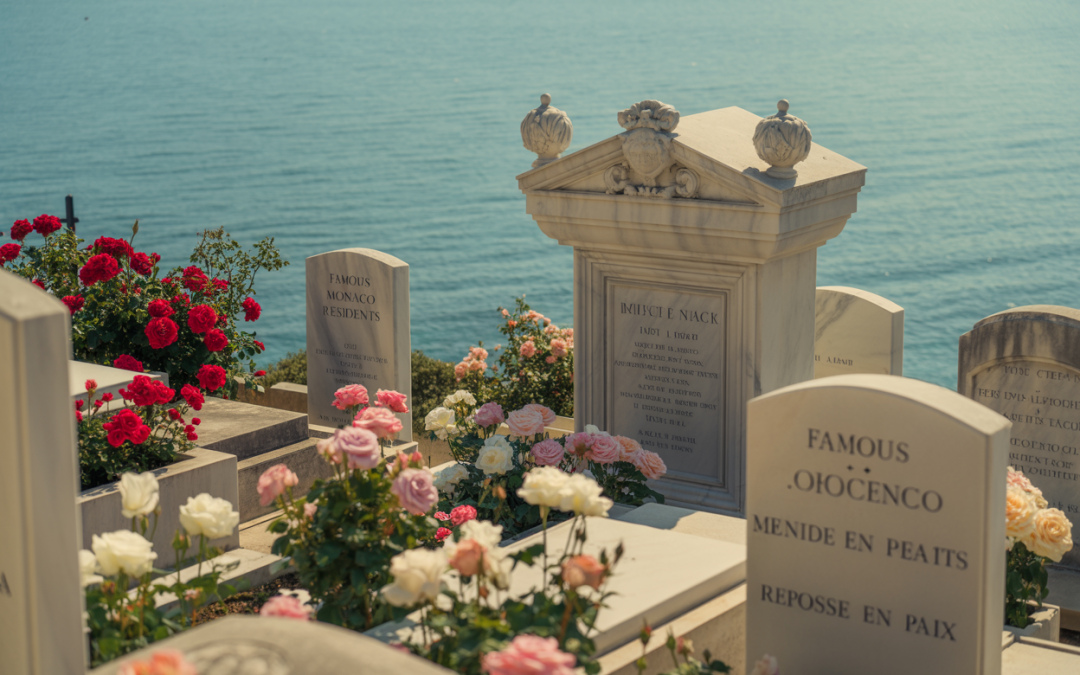Key Takeaways
- Monaco’s Cemetery is home to various celebrities including Princess Grace Kelly, Sir Roger Moore, and Josephine Baker, making it one of the most prestigious final resting places in Europe.
- The Grimaldi royal family traditionally rests in the Saint Nicholas Cathedral, where visitors can pay respects to Princess Grace whose grave is often adorned with roses.
- Monaco’s Cemetery boasts Europe’s largest columbarium with 546 niches, reflecting the Principality’s high 60% cremation rate.
- Formula 1 legends like Jules Bianchi and Louis Chiron have chosen Monaco as their eternal home, connecting the cemetery to Monaco’s rich racing heritage.
- Beyond its famous residents, the cemetery offers breathtaking Mediterranean views and stands as a cultural landmark dating back to 1868.
Monaco, the glittering jewel of the Mediterranean, attracts the rich and famous in life—and as it turns out, in death as well. The tiny principality’s cemetery serves as the final resting place for royalty, Hollywood stars, racing legends, and entertainment icons who found the allure of Monaco impossible to resist even in their eternal slumber. Perched on a cliff overlooking the brilliant blue Mediterranean, this cemetery is as exclusive in death as Monaco is in life.
Monaco’s Prestigious Final Resting Place: More Than Just a Cemetery
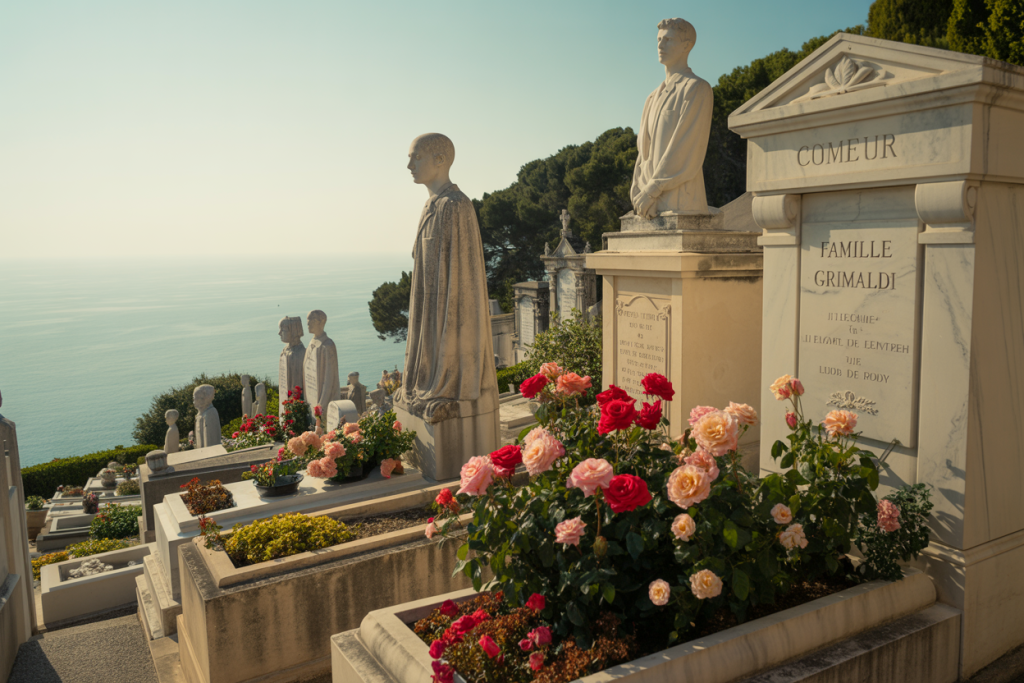
Famous People Burried in Monaco
Established in 1868, Monaco’s Cemetery sits majestically on the border with Cap d’Ail, offering sweeping views of the sea that once captivated its permanent residents. More than just a burial ground, it’s a chronicle of Monaco’s rich cultural tapestry where Monegasque families share space with international celebrities who fell in love with the principality. The cemetery has become a unique destination where history, celebrity, and breathtaking natural beauty converge in unexpected harmony.
What makes Monaco’s cemetery particularly special is not just who lies within its grounds, but also its distinct features. With its terraced design cascading down the cliffside, ornate family mausoleums, and immaculately maintained grounds, it stands as one of Europe’s most beautiful cemeteries. The location itself speaks to Monaco’s approach to honoring the deceased—providing them with the same spectacular views and Mediterranean splendor that they enjoyed in life.
The cemetery also holds the distinction of having Europe’s largest columbarium, with 546 niches—a reflection of Monaco’s high cremation rate of 60%. This modern approach to eternal rest, combined with traditional burial practices, showcases Monaco’s blend of respecting tradition while embracing contemporary sensibilities.
The Royal Legacy: Grimaldi Family Tombs in Monaco
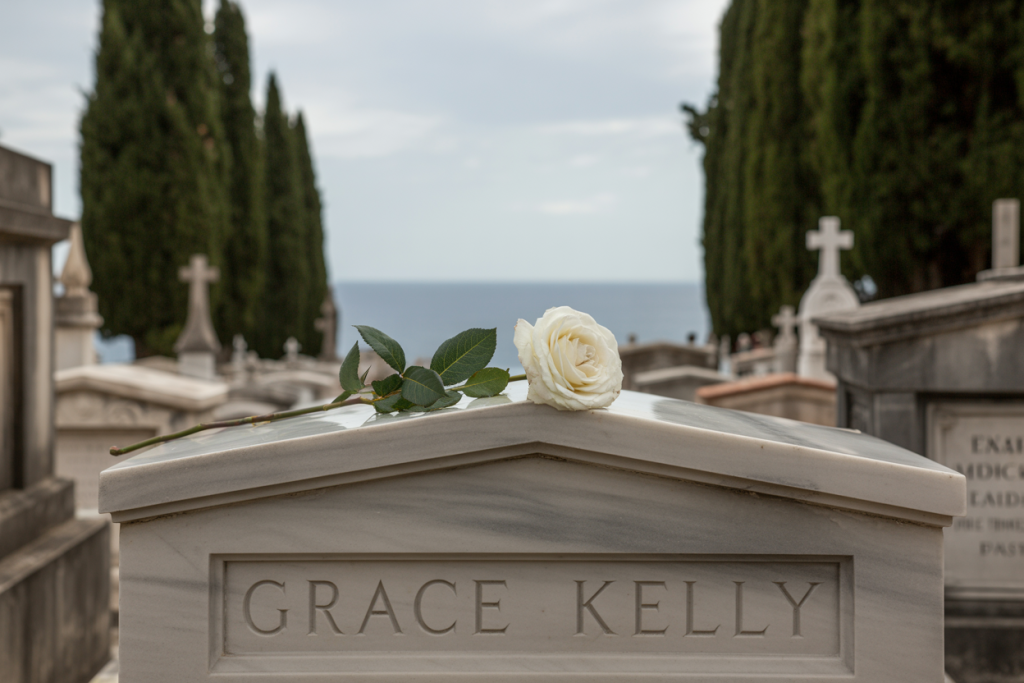
“The Grimaldi family has ruled Monaco for over 700 years, and their final resting place reflects both their royal status and deep connection to the principality. While many famous residents lie in the Monaco Cemetery, the Grimaldi sovereigns are traditionally entombed in the crypt of Saint Nicholas Cathedral in Monaco-Ville, creating a royal necropolis that spans generations of Monaco’s ruling family.”
The Cathedral of Monaco, a Romanesque-Byzantine church built in 1875, serves as the spiritual and historical heart of the principality. Within its white stone walls lies the Grimaldi crypt, where Monaco’s princes have been laid to rest since the cathedral’s construction. This tradition of royal burial creates a powerful connection between Monaco’s past and present, with each sovereign joining their ancestors in this sacred space. For those planning to visit, discover what to do in Monaco in one day to make the most of your trip.
For visitors to Monaco, the cathedral holds special significance as the site of numerous royal events, from joyous occasions like the wedding of Prince Rainier III to Grace Kelly to solemn ceremonies marking the passing of monarchs. The cathedral stands as both a working church for Monaco’s Catholic faithful and a monument to the Grimaldi dynasty that has shaped this tiny nation’s outsized global presence.
Prince Rainier III and Princess Grace Kelly
Perhaps the most visited graves in Monaco belong to Prince Rainier III and his beloved wife, Princess Grace Kelly. Their love story captivated the world—a Hollywood beauty who abandoned stardom to become a real-life princess. When Grace died tragically in a car accident in 1982, her funeral drew mourners from around the world. Prince Rainier, who never remarried, requested to be buried alongside her when he passed in 2005 after ruling Monaco for over 50 years. Their joint tomb in the Cathedral of Monaco has become a pilgrimage site for fans of both royal history and classic Hollywood.
Prince Albert I: The Explorer Prince
Among Monaco’s most fascinating royal residents is Prince Albert I, whose tomb in the cathedral honors a man far ahead of his time. Known as the “Navigator Prince,” Albert I devoted his life to oceanography, founding Monaco’s renowned Oceanographic Museum. His scientific expeditions and commitment to environmental causes in the late 19th and early 20th centuries established Monaco as a center for marine research long before environmental conservation became a global concern.
His elaborate tomb, adorned with maritime motifs, celebrates not just a ruler but a scientist whose contributions to oceanography earned him respect from the scientific community worldwide. Prince Albert I’s legacy lives on not only in his final resting place but in Monaco’s continued commitment to marine research and conservation.
Other Royal Family Members
The cathedral crypt houses numerous members of the extended Grimaldi family, creating a genealogical map of Monaco’s ruling dynasty. Princess Antoinette, Prince Rainier’s sister and once a controversial figure in Monegasque succession politics, rests here alongside Princess Charlotte, whose decision to renounce her succession rights paved the way for her son Rainier to become prince. Each tomb tells a story of Monaco’s complex royal history, with its power struggles, strategic marriages, and occasional scandals that have kept the Grimaldi name in headlines for generations.
Hollywood Stars Who Chose Monaco as Their Eternal Home
Monaco’s allure extended beyond its beaches and casinos to become the final choice for several entertainment giants. The principality’s cemetery holds a surprising collection of Hollywood legends who, having discovered Monaco during its glamorous heyday, chose to make it their eternal home. These celebrities found in Monaco a haven away from the spotlight, where they could enjoy privacy in life and dignity in death.
For many film stars, Monaco represented European sophistication and old-world charm, qualities that stood in stark contrast to Hollywood’s often frenetic pace. The decision to be buried in Monaco rather than Hollywood reflects not just a lifestyle choice but a final statement about identity and belonging. These stars, having traveled the world, ultimately chose the small Mediterranean principality as the place where they felt most at home, enjoying its unique culture and even indulging in local delicacies like Fougasse Monegasque.
While Hollywood has its Walk of Fame, Monaco’s cemetery offers a more contemplative tribute to entertainment royalty—one where fans can pay their respects in a setting of extraordinary natural beauty rather than amid the tourist bustle of Los Angeles. This collection of entertainment legends has transformed a portion of Monaco’s cemetery into an unexpected monument to film history.
Sir Roger Moore: The Monaco Bond
Sir Roger Moore, who embodied James Bond through seven films from 1973 to 1985, made Monaco his home for decades before his death in 2017. The debonair actor was drawn to Monaco’s sophistication and privacy, qualities that aligned perfectly with his own elegant persona. His grave in Monaco Cemetery has become a destination for Bond fans worldwide, who leave playing cards, miniature martini glasses, and other 007-themed tributes to commemorate the actor who brought a distinct charm and wit to the role of Britain’s most famous spy.
Anthony Burgess: A Clockwork Legacy
Literary giant Anthony Burgess, best known for his novel “A Clockwork Orange,” also rests in Monaco’s cemetery. The British writer and composer spent his later years in Monaco, attracted by both its cultural atmosphere and favorable tax situation. Burgess, who wrote over fifty books and composed numerous musical works, found in Monaco a cosmopolitan setting that nurtured his creative spirit. His grave, more understated than some of his neighbors’, reflects the quiet dignity that characterized his life in the principality.
Entertainment Icons in Monaco’s Cemetery
Beyond Hollywood, Monaco’s cemetery houses entertainment legends from various fields who found themselves drawn to the principality’s unique blend of glamour and privacy. These performers, having dazzled audiences around the world, chose Monaco as their final curtain call. Their graves, often visited by fans making pilgrimages to honor their artistic contributions, have become cultural landmarks within the cemetery’s grounds.
What connects these diverse talents is not just their artistic achievements but their embrace of Monaco as a place where they could be both celebrities and private citizens. In a world where fame often comes at the cost of privacy, Monaco offered these stars a rare combination of international sophistication and personal security. This balance proved so appealing that many made the conscious choice to remain in Monaco not just for their retirement years but for eternity.
The concentration of artistic talent in Monaco’s cemetery creates a fascinating juxtaposition to the principality’s reputation for banking and luxury. Beyond the casinos and yachts, these graves remind visitors that Monaco has long been a cultural haven where creative spirits found inspiration and, ultimately, peace.
Josephine Baker: From St. Louis to Monaco to the Panthéon
The extraordinary Josephine Baker, who revolutionized entertainment as a dancer, singer, and civil rights activist, was buried in Monaco’s cemetery in 1975. Princess Grace herself attended the funeral, underscoring the deep friendship between the two American-born women who had found new identities in Europe. Baker’s grave became a place of pilgrimage for admirers of her groundbreaking career and courageous stance against racial discrimination, adorned frequently with bananas in tribute to her famous banana skirt costume.
Marie Bell: French Theater Royalty
Marie Bell, the legendary French actress and theater director who became the first woman to lead the Comédie-Française, rests among Monaco’s distinguished dead. Her grave honors a woman whose dramatic talents made her one of France’s most respected theatrical figures of the 20th century. Bell, who owned a theater in Paris that now bears her name, chose Monaco as her final resting place, adding her artistic legacy to the principality’s cultural heritage.
Léo Ferré: Monaco’s Musical Son
Monaco-born Léo Ferré, one of the most influential French-language singers and composers of the post-war era, returned to his homeland in death after a life spent largely in France. Known for his anarchist politics and poetic lyrics, Ferré created a body of work that revolutionized French chanson with its blend of classical influences and provocative social commentary. His grave in Monaco acknowledges his roots in the principality while honoring an artist whose creative vision often challenged the established order. Learn more about Monaco’s unique culture with this Fougasse Monegasque recipe.
Racing Legends at Rest in Monaco
Monaco’s identity is inextricably linked with motorsport, hosting the most prestigious Formula 1 race in the world since 1929. It seems fitting, then, that several racing legends have chosen the principality’s cemetery as their final resting place. These drivers and racing innovators, who once navigated Monaco’s legendary street circuit at breakneck speeds, now rest peacefully overlooking the same Mediterranean waters that frame the race’s most iconic views.
The presence of these racing figures in Monaco’s cemetery creates a poignant connection between the principality’s most famous sporting event and those who helped shape its legacy. For racing enthusiasts, visiting these graves offers a moment to reflect on Monaco’s unique contribution to motorsport history and the courageous individuals who pushed the boundaries of speed and skill on its challenging streets.
Each May, when Formula 1 returns to Monaco, these graves take on special significance as the modern incarnation of the sport pays homage to its roots. The roar of engines through Monaco’s streets serves as an annual tribute to the pioneers who rest in the cemetery above, having written their names into racing history on the very same roads.
Jules Bianchi: Formula 1’s Fallen Star
The grave of Jules Bianchi represents one of racing’s most tragic stories. The promising French driver, who died in 2015 following injuries sustained during the 2014 Japanese Grand Prix, was laid to rest in Monaco where he had lived. At just 25 years old, Bianchi was considered one of Formula 1’s brightest talents, with a Ferrari future seemingly assured before his fatal accident. His grave has become a site of pilgrimage for racing fans, who leave miniature helmets, toy cars, and racing memorabilia to honor his memory and unfulfilled potential.
Louis Chiron: Monaco’s First Racing Hero
Louis Chiron, Monaco’s homegrown racing legend, holds the distinction of being the oldest driver to compete in Formula 1 and the only Monegasque to win his home Grand Prix (albeit before it was part of the F1 championship). His grave honors a career that spanned the pre-war and post-war eras of grand prix racing, establishing him as one of the sport’s most enduring figures. The Monegasque racing driver’s legacy lives on not just in his final resting place but in the “Swimming Pool Chiron” corner of the Monaco circuit and the Bugatti Chiron supercar named in his honor.
“Louis Chiron embodied Monaco’s racing spirit like no other. Born in the principality in 1899, his racing career spanned an astonishing five decades. Even today, he holds the record as the oldest driver to compete in Formula 1, having raced in the Monaco Grand Prix at age 55. His grave reminds us that before the glamour and global attention, Monaco’s racing tradition began with one of its own sons.”
Anthony Noghès: Creator of the Monaco Grand Prix
Among Monaco’s most influential citizens resting in the cemetery is Anthony Noghès, the visionary who created the Monaco Grand Prix in 1929. As the founder of the Automobile Club of Monaco, Noghès convinced Prince Louis II to transform the principality’s streets into a racing circuit, forever changing Monaco’s identity and tourism appeal. His grave serves as a reminder of how one man’s passion for motorsport helped establish Monaco’s place in global sporting culture and created what would become Formula 1’s crown jewel event.
Noghès’ contribution to Monaco extends beyond the race itself—he essentially created the template for Monaco’s modern identity as a sporting and entertainment destination that attracts global attention. The final chicane of the Monaco circuit, the Noghès Corner, bears his name as a perpetual tribute to his transformative vision for the principality.
Business Figures and Monaco Residents
Beyond royalty, entertainment stars, and racing figures, Monaco’s cemetery contains the graves of numerous business leaders and prominent residents who contributed to the principality’s development. These individuals, though perhaps less internationally recognized than their celebrity neighbors, played crucial roles in shaping Monaco’s economy, infrastructure, and society. Their presence in the cemetery reflects Monaco’s status not just as a playground for the rich and famous but as a community with deep roots and multi-generational connections.
The business leaders interred in Monaco often represent the cosmopolitan nature of the principality itself—entrepreneurs from across Europe who recognized Monaco’s unique advantages and helped build its reputation as a center for banking, shipping, real estate, and other industries. Their graves, sometimes marked with symbols of their professional achievements, tell the story of Monaco’s economic development alongside its glamorous image.
Stefano Casiraghi: Princess Caroline’s Husband
The tragic story of Stefano Casiraghi, who died in a powerboat racing accident in 1990, is memorialized in Monaco’s cemetery. As the husband of Princess Caroline and father to three of her children, Casiraghi’s death at just 30 years old shocked the principality and the royal family. An Italian businessman and daredevil powerboat racer, Casiraghi had embraced Monaco as his home during his seven-year marriage to Princess Caroline. His grave has become a place for both the Grimaldi family and the public to remember a life cut short in pursuit of sporting glory.
The Monaco Cemetery: A Place of Beauty and Reflection
More than just a collection of famous graves, Monaco’s cemetery stands as an architectural and landscaping achievement in its own right. Built on terraced levels that follow the natural contours of the rocky hillside, the cemetery maximizes its dramatic location while creating intimate spaces for reflection. Mediterranean cypress trees provide vertical accents against the horizontal tombs, while carefully maintained flowering plants add color throughout the year. The cemetery’s design balances the dignity required of a burial ground with the aesthetic sensibility for which Monaco is known.
The cemetery’s evolution since its establishment in 1868 reflects changing attitudes toward death and remembrance. From ornate family mausoleums favored in the 19th century to the more modern columbarium niches, the site showcases funerary traditions spanning over 150 years. Despite numerous renovations and expansions over the decades, the cemetery has maintained its character while adapting to contemporary needs.
Location and Architecture
Situated on the border between Monaco and Cap d’Ail, the cemetery occupies one of the most valuable pieces of real estate in the world—a testament to Monaco’s commitment to honoring its dead with an unparalleled view. The terraced design follows the Mediterranean tradition of hillside cemeteries, creating a series of platforms connected by stairs and pathways that invite contemplative wandering. A central chapel provides a focal point and venue for funeral services, while the extensive columbarium represents a modern addition to this historic site.
The cemetery’s architecture combines traditional Mediterranean elements with the distinctive white stone that characterizes many of Monaco’s significant buildings. Family tombs range from simple marble slabs to elaborate mini-temples, often adorned with bronze sculptures, religious imagery, and personal mementos that offer glimpses into the lives being commemorated. For more about its history, explore Monaco Cemetery’s 150 years of history.
The Monaco Columbarium
Monaco’s columbarium stands as Europe’s largest, containing 546 niches for cremated remains—an impressive achievement for such a small territory. The structure’s size reflects Monaco’s high cremation rate of 60%, significantly above the European average. This modern approach to interment allows more Monegasque residents to remain within the principality’s limited borders after death, maintaining their connection to the community they chose in life.
Feature Details Significance Columbarium Size 546 niches Largest in Europe Cremation Rate 60% of Monaco deaths Significantly above European average Cemetery Founding 1868 Over 150 years of history Notable Feature Mediterranean view One of the world’s most scenic cemeteries Memorial Ceremonies and Traditions
The Monaco Cemetery hosts several significant ceremonies throughout the year, particularly around All Saints’ Day and Remembrance Day. These events often include representatives from the Grimaldi family, maintaining the close connection between Monaco’s rulers and citizens. A commemorative stele, inaugurated by Prince Albert II in 2015, provides a focal point for ceremonies honoring those deported from Monaco during World War II, ensuring that even in a cemetery known for celebrity graves, the principality’s darker historical moments are not forgotten.
Traditional Monegasque funeral customs blend Catholic traditions with Mediterranean practices, including the custom of family members maintaining graves with fresh flowers and personal mementos. Even for the most famous graves, like Princess Grace’s, the tradition of leaving fresh roses continues decades after her passing—a testament to Monaco’s commitment to honoring its notable residents with the same care whether they were royalty, celebrities, or ordinary citizens. For more insights on Monaco’s cemeteries, you can explore Monaco Cemetery’s 150 years of history.
Visiting These Famous Graves: What You Need to Know
Monaco’s cemetery welcomes respectful visitors year-round, offering a unique perspective on the principality’s history and cultural significance. Unlike some exclusive aspects of Monaco life, the cemetery is accessible to all visitors free of charge, providing an democratic opportunity to connect with the principality’s past and present. For travelers interested in celebrity history, royal heritage, or simply seeking a peaceful spot with magnificent views, the cemetery offers an often-overlooked destination away from Monaco’s more publicized attractions.
Best Times to Visit
The cemetery is open daily to visitors, though opening hours vary seasonally. Morning visits offer the best lighting for photography and the most comfortable temperatures, especially during summer months when afternoon heat can make the hillside location challenging to explore. Weekday mornings typically provide the quietest experience, allowing for contemplative exploration without crowds.
Visiting around All Saints’ Day (November 1) provides a glimpse into local traditions as Monegasque families decorate family graves with chrysanthemums and other flowers. However, this period may feel more intrusive for tourists as families conduct their remembrance rituals. Spring visits offer the advantage of blooming gardens throughout the cemetery, adding color to the white stone monuments.
Winter visits, particularly on clear days, provide exceptional visibility across the Mediterranean and along the coastline. The cemetery’s elevated position captures dramatic sunlight during the shorter winter days, creating memorable photographic opportunities of both the graves and the surrounding panorama. The mild Mediterranean winter also makes outdoor exploration comfortable even in January and February.
“There is something deeply moving about standing in Monaco’s cemetery as the sun sets over the Mediterranean. In that moment, you understand why so many notable people chose this spot as their eternal resting place. The beauty is overwhelming, the silence profound, and the sense of history palpable. It’s a reminder that Monaco offers not just glamour in life, but dignity and majesty in death. If you’re planning a visit, here’s what to do in Monaco in one day to make the most of your trip.”
Cemetery Etiquette
Visitors should maintain the respectful atmosphere appropriate to a cemetery, speaking quietly and avoiding disruptive behavior. Photography is permitted, though visitors should exercise discretion, particularly when photographing graves where family members may be present. Remember that despite the celebrity status of many interred here, the cemetery remains primarily a place of mourning and remembrance for families.
Appropriate attire is expected, with modest clothing recommended both out of respect and for practical reasons—the terraced layout involves considerable walking on steps and inclines. Bringing water is advisable, especially in summer months, as the hillside location offers limited shade. While touching monuments or leaving tributes at celebrity graves has become common practice, visitors should avoid any actions that might damage the memorials or disturb existing tributes.
Notable Memorials and Monuments
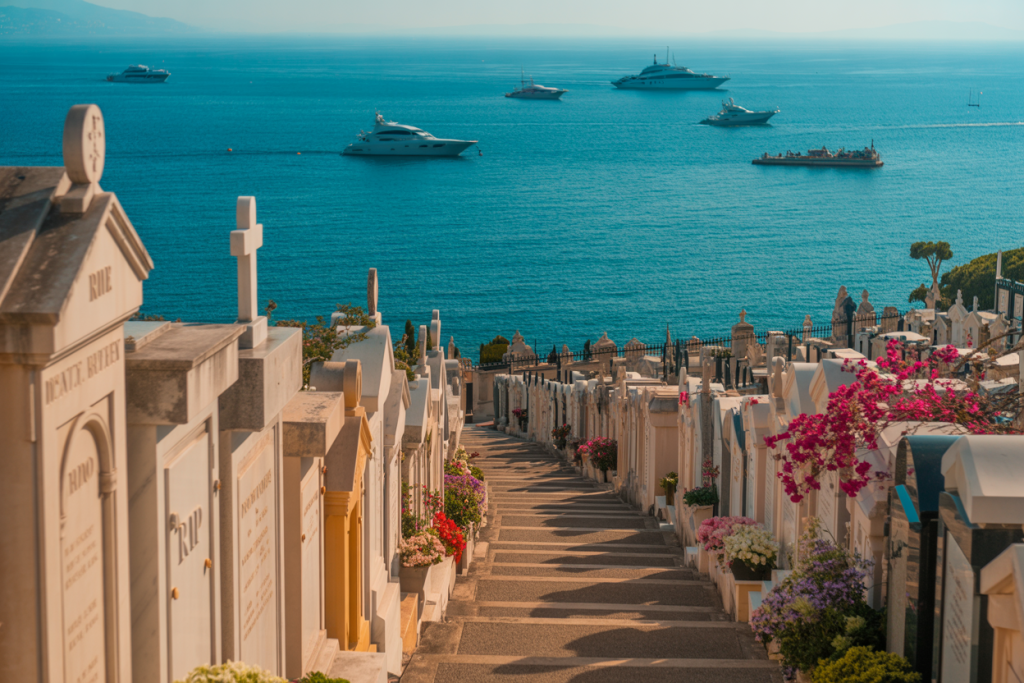
Beyond individual graves, several monuments within the cemetery deserve special attention. The World War II memorial provides historical context to Monaco’s experience during the conflict, including the deportation of Jewish residents. The central chapel, though small, contains beautiful architectural details and occasionally hosts services. The monument to Monaco’s war dead offers a reminder of how even this neutral principality was touched by the great conflicts of the 20th century.
The cemetery’s military section contains uniformly designed graves for service members, creating a striking visual contrast to the individualized monuments elsewhere. Several collective family mausoleums belonging to Monaco’s oldest families feature exquisite craftsmanship and architectural details that showcase the principality’s artistic heritage. These structures, some dating back to the cemetery’s founding, represent significant examples of 19th-century funerary art.
Monaco’s Cemetery: Where History, Celebrity, and Breathtaking Views Meet
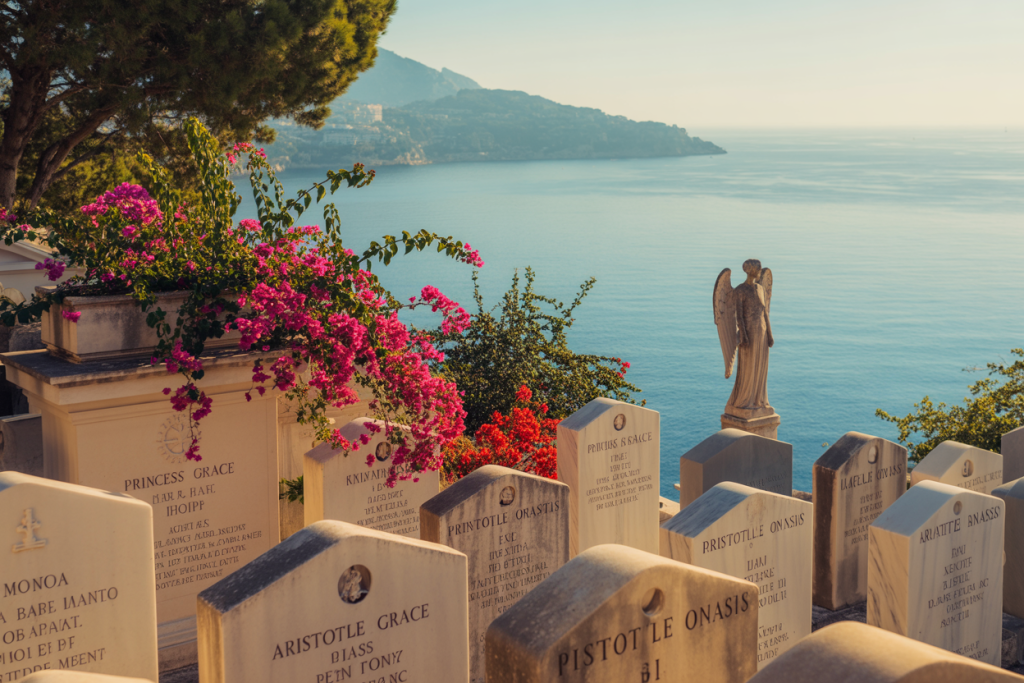
The cemetery of Monaco represents far more than a collection of famous graves—it embodies the principality’s unique blend of tradition and glamour, set against one of the Mediterranean’s most spectacular backdrops. From royalty to racing drivers, Hollywood stars to homegrown talents, the diverse individuals who rest here tell the story of Monaco’s outsized cultural impact despite its tiny geographical footprint. For visitors seeking to understand Monaco beyond its casinos and yachts, the cemetery offers a contemplative window into the principality’s soul, where the famous and ordinary share the same breathtaking view of the sea that defined their chosen homeland.
Frequently Asked Questions
Where exactly is the Monaco Cemetery located?
The Monaco Cemetery is situated on the western edge of the principality, on the border with the French town of Cap d’Ail. It occupies a dramatic hillside position above the Mediterranean Sea, accessible via Avenue de Saint-Laurent in the Monaco-Ville district. The cemetery’s elevated location provides panoramic views of the coastline and sea, making it not just a place of remembrance but also one of Monaco’s most scenic lookout points.
Visitors can reach the cemetery on foot from the center of Monaco, though the uphill walk is quite steep. Public buses stop nearby, and taxis can provide direct access. The cemetery’s terraced design follows the natural contours of the hillside, with different levels connected by staircases that may present accessibility challenges for some visitors.
Can tourists visit the graves of Princess Grace and Prince Rainier?
Yes, tourists can visit the tombs of Princess Grace and Prince Rainier III, though they are not located in the main Monaco Cemetery but rather in the Cathedral of Monaco (Cathédrale Notre-Dame-Immaculée) in Monaco-Ville. The royal couple’s tombs are accessible during the cathedral’s opening hours, and visitors are welcome to pay their respects provided they maintain appropriate church behavior. Princess Grace’s grave is particularly easy to identify as it’s frequently adorned with fresh roses, her favorite flower.
Why did so many celebrities choose to be buried in Monaco?
Celebrities chose Monaco as their final resting place for many of the same reasons they lived there: privacy, beauty, prestige, and connection to the community. Many had established deep ties to Monaco during their lifetimes, becoming legal residents and part of the principality’s social fabric. The cemetery’s spectacular setting overlooking the Mediterranean offered an eternal view matching the glamorous lifestyle these luminaries had enjoyed. Additionally, Monaco’s stability and commitment to maintaining its heritage provided assurance that their graves would be well-preserved and respected for generations to come.
Is Josephine Baker’s body still in Monaco after her Panthéon ceremony?
Yes, Josephine Baker’s body remains in Monaco’s cemetery despite her 2021 ceremonial induction into France’s Panthéon. The Panthéon ceremony honored Baker with a cenotaph (a memorial containing no body) and soil from various locations significant to her life, including Monaco. Her family chose to respect her wish to remain buried in Monaco, where she had strong connections to Princess Grace and the principality. This arrangement allows Baker to be honored in both locations—in the Panthéon as a French national hero and in Monaco as a beloved adopted resident.
Are there any special days when the cemetery holds public ceremonies?
The Monaco Cemetery hosts several public ceremonies throughout the year, most notably on All Saints’ Day (November 1) and during Remembrance Day observations in November. A special ceremony also takes place annually at the World War II memorial, commemorating those deported from Monaco during the occupation. Prince Albert II often attends these ceremonies, continuing the Grimaldi tradition of maintaining close connections with the principality’s citizens both living and deceased. These events provide visitors a glimpse into Monaco’s community spirit and how the small nation honors its history. For more insights into the cemetery’s significance, explore Monaco Cemetery’s 150 years of history.
Beyond Monaco’s famous casino and glamorous Grand Prix, the principality’s cemetery offers a uniquely peaceful window into the lives and legacies of those who made this tiny nation their home. From Hollywood legends to racing heroes, royalty to artists, the cemetery tells Monaco’s story through those who chose to remain part of it eternally.
For those looking to understand Monaco beyond its glittering surface, a visit to these famous graves provides insight into the principality’s remarkable cultural significance and the diverse personalities who shaped its identity. The cemetery stands as a testament to Monaco’s ability to attract extraordinary individuals who, having traveled the world, chose this small corner of the Riviera as their final destination.
The next time you visit Monaco, take a moment away from the casinos and cafés to climb to this peaceful spot where history, celebrity and breathtaking beauty converge. In the quiet paths between famous graves, you’ll discover a different side of Monaco—one where legacy and memory create perhaps the principality’s most exclusive gathering of all. If you only have a short time, here’s a guide on what to do in Monaco in one day to make the most of your visit.
Experience Monaco’s fascinating heritage through the stories of those who rest in its cemetery with HelloMonaco’s cultural tours, which offer expert insights into the principality’s most notable residents and their lasting contributions. For a unique culinary experience, explore the Fougasse Monegasque recipe, a traditional treat that adds flavor to Monaco’s rich cultural tapestry.
MonacoNewsDaily.com is a solo project by me, Christal Céleste, a resident of Monaco since 1990. I've practically grown up alongside this unique city-state, and I'm passionate about sharing my experience and insider knowledge with you.
Monaco isn't just a place to visit, it's a lifestyle. And I've been lucky enough to immerse myself in it all. From catching waves on Monaco's exclusive beaches to soaking up the Riviera sun on a private yacht, I've experienced the full spectrum of luxury this playground offers.
But Monaco is more than just glamour. I've also tried my luck at the legendary Casino de Monte Carlo, savored exquisite lunches at Alain Ducasse's restaurants, and enjoyed lively dinners at the waterfront. For my casual escape, there's nothing like strolling Monaco's picturesque main road, soaking in the sights & atmosphere.
When I'm not writing you might find me on the courts at the Monte-Carlo Country Club, teeing off at the Monaco Golf Club, or channeling my inner Grace Kelly with a spin in an exotic car. But Monaco's charm extends beyond the fast lane. There's a simple pleasure in strolling the Rocher with local friends.
In the afternoon you might catch me unwinding at a cozy little Italian flavored coffee shop around the corner of the Royal Palace with that perfectly frothy cappuccino.
As the sun dips below the horizon, painting the sky in vibrant hues, you might find me sipping my favorite aperitif on the rooftop at Buddha-Bar, enjoying the stunning views. Champagne, after all, is a celebration in itself, or simply the perfect way to toast another beautiful day in Monaco.
My finger is always on the pulse of Monaco. Whether it's the latest trends or hidden gems, I'm here to guide you through the magic of this little corner of the world. Join me on this journey to discover Monaco!

